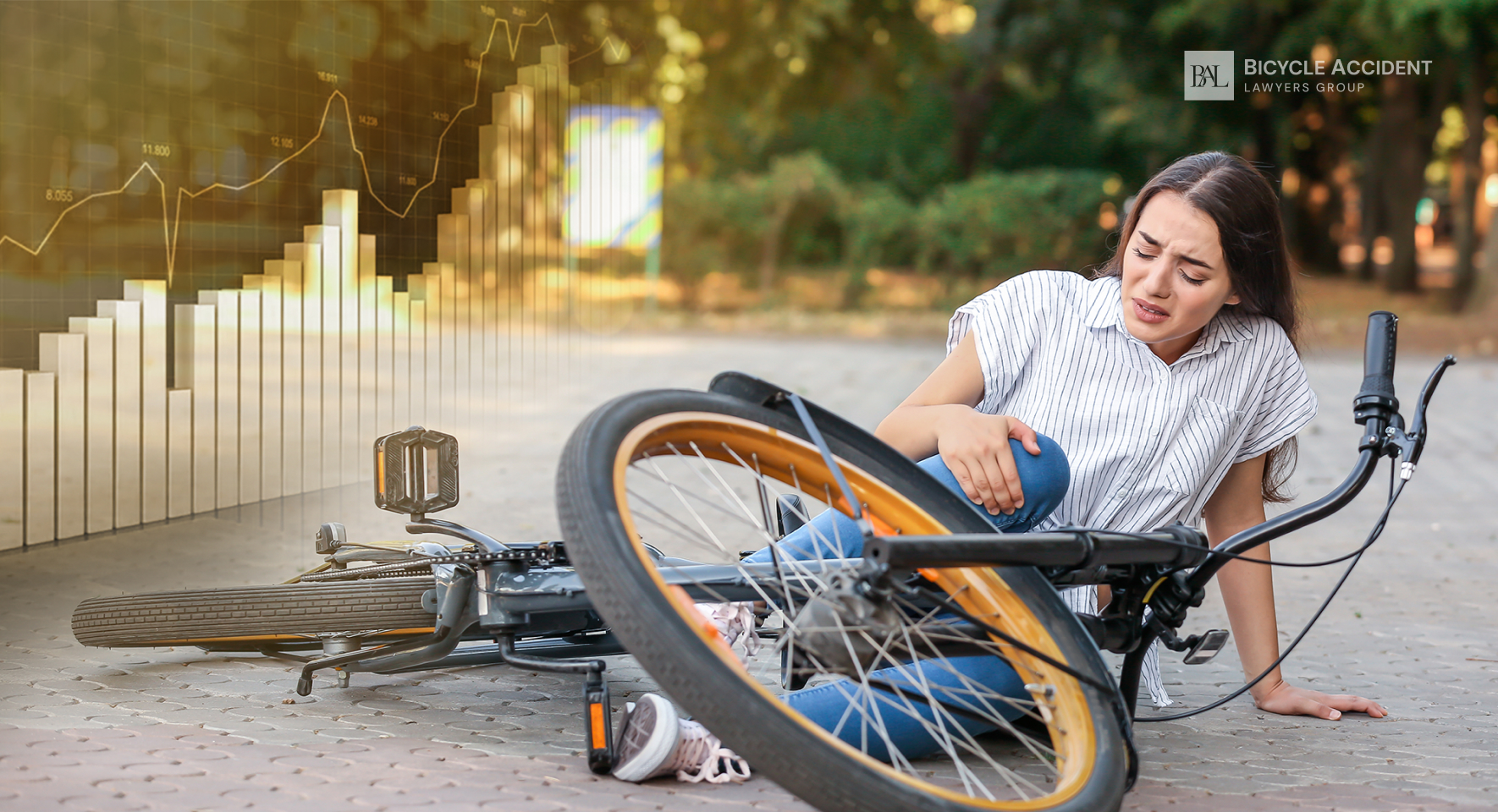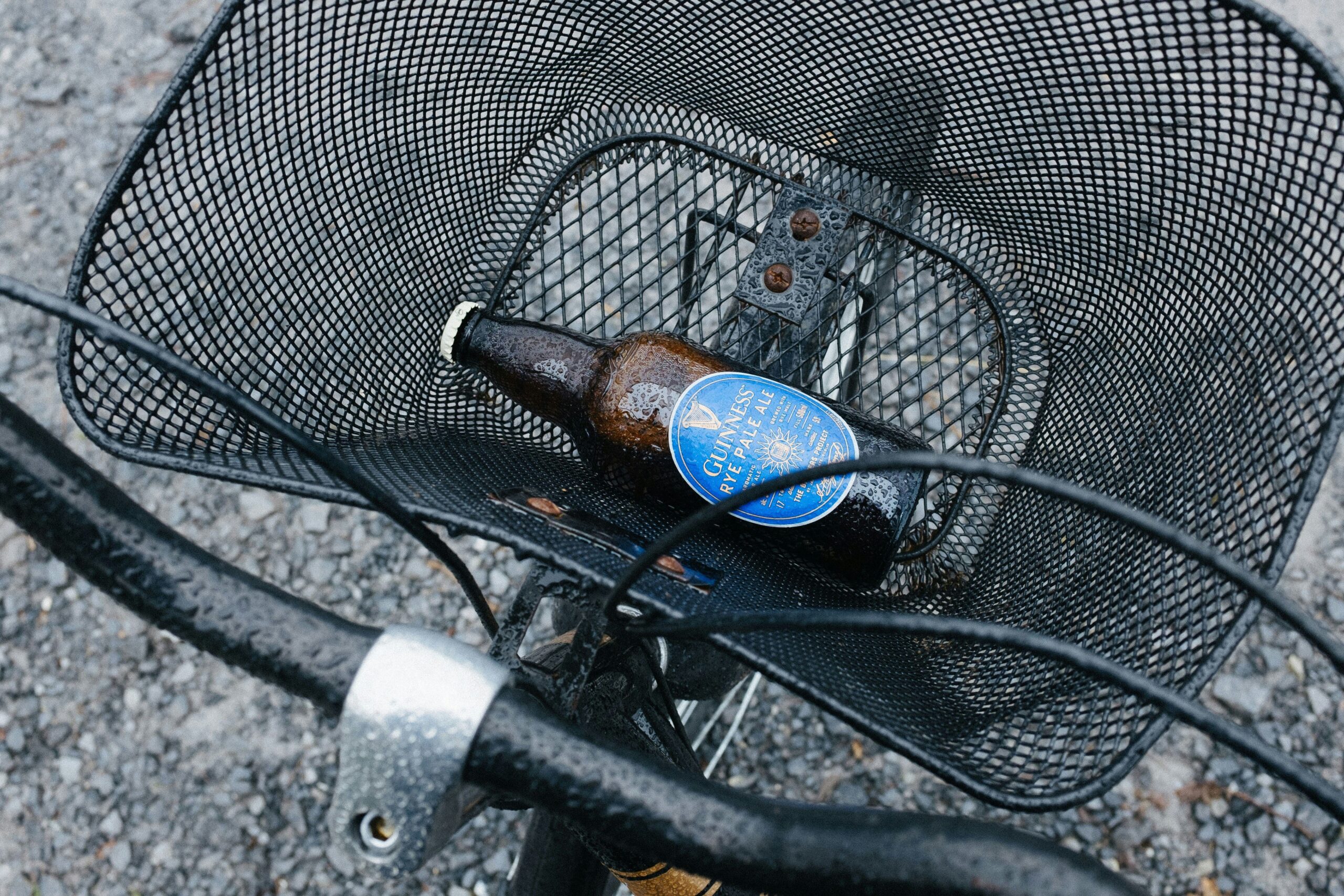- Key Bicycle Accident Statistics
- Bicycle Death Trend Over Past Years
- Bicycle Death Statistics by State
- 10 Most Dangerous States for Cyclists
- 10 Safest States for Cyclists
- Bicycle Death Statistics by City
- Bicycle Death Statistic by Month
- Bicycle Death Statistic by Time
- Bicycle Death Statistic by Location Type
- Bicycle Death Statistic by Age and Sex
- Bicycle Death Statistic by Helmet Use
- Bicycle Death with Alcohol in Blood Statistics
- Bicycle Death Statistics by Point of Impact
- Bicycle Death Statistics by Vehicle Type
- Effective Ways to Decrease Bicyclist Fatality Rates in the USA
- Conclusion
- Methodology Used for 2024 Forecasts
- Resources
- Get a FREE case evaluation today
The 2025 complete bicycle accident statistics highlight how cycling has grown into a popular mode of transportation across the United States. More workers of all ages are choosing bikes for daily commutes, with ridership rates increasing from 0.4% in 2021 to 0.5% in 2023.
However, as with any other activity, cycling comes with a variety of risks to be on the lookout for. Bicyclists get seriously, if not fatally, injured at a concerning rate all over the country. In 2023, over 1.1K riders were killed, and almost 50K were severely wounded in the US. As the number of preventable bicyclist deaths is on the rise, every cyclist in America has to be aware of the recent trends to improve their road safety stats.
Key Bicycle Accident Statistics
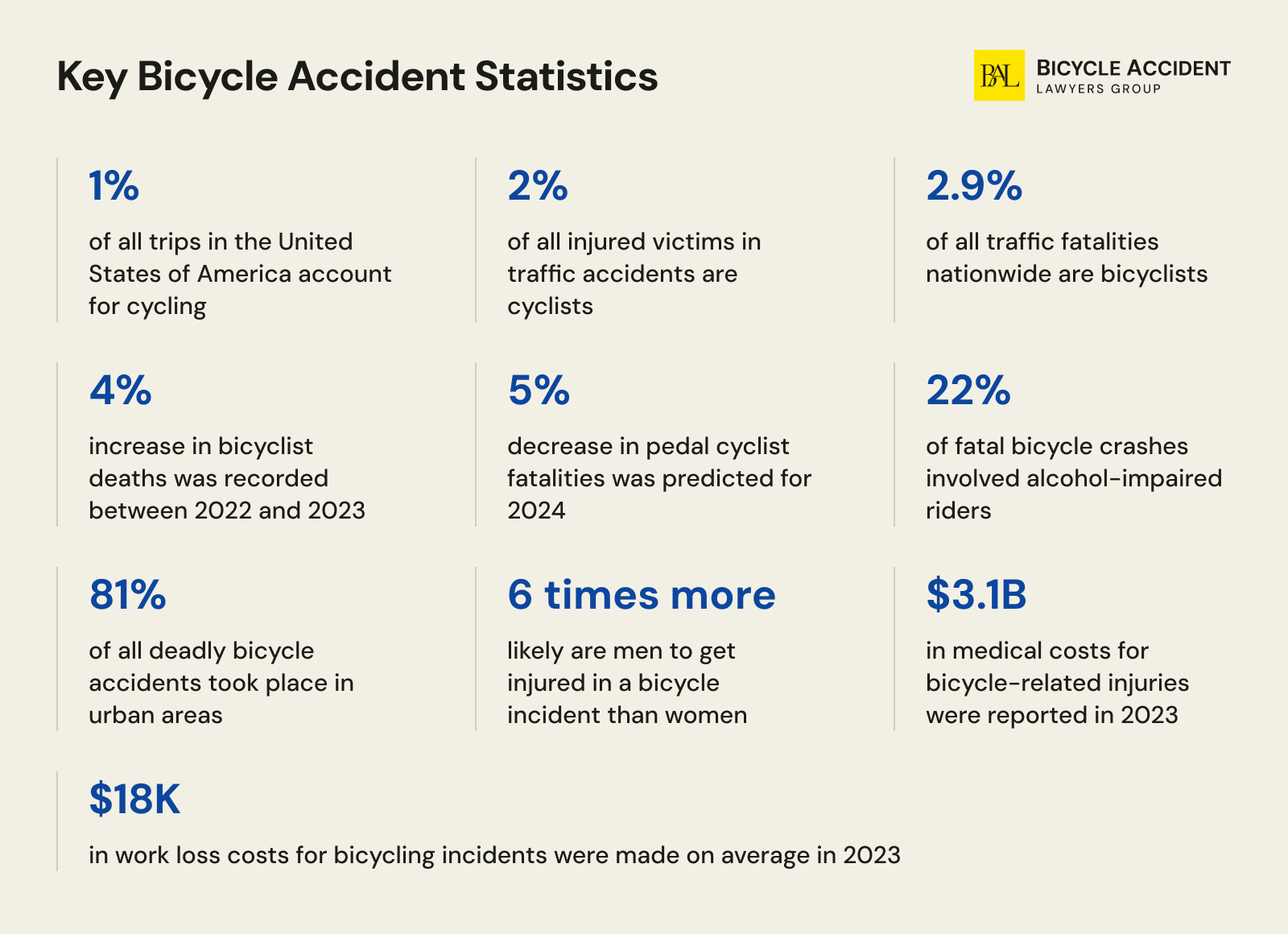
- Cycling accounts for 1% of all trips in the United States.
- 2% of all injured victims in traffic accidents are cyclists.
- 2.9% of all traffic fatalities nationwide are bicyclists.
- A 4% increase in bicyclist deaths was recorded between 2022 and 2023.
- An almost 5% decrease in pedal cyclist fatalities was predicted for 2024.
- 22% of fatal bicycle crashes involved alcohol-impaired riders.
- 81% of all deadly bicycle accidents took place in urban areas.
- Men are 6 times more likely to get injured in a bicycle incident than women.
- Medical costs for bicycle-related injuries totaled around $3.1 B in 2023.
- Work loss costs for bicycling incidents averaged around $18K in 2023.
Bicycle Death Trend Over Past Years
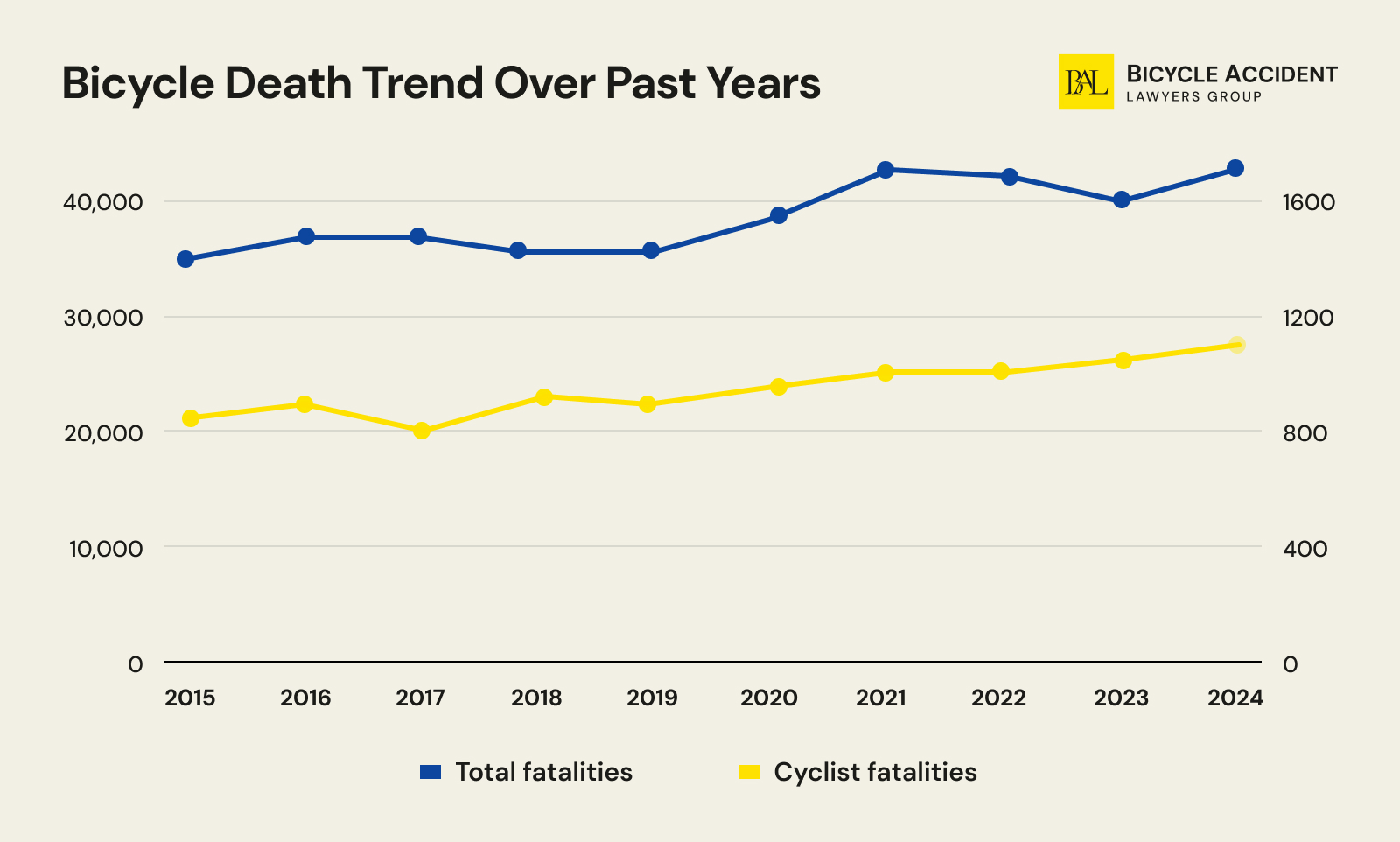
Over the past ten years, cyclist fatalities spiked by almost 22%, and a few factors contributed to the greater number of bicyclists killed in the USA. Nowadays, more and more adults use bicycles as their favorite means of transportation. On top of that, the congestion rates in larger cities continue to spike, and busy roads without proper cycling infrastructure pose a serious threat to vulnerable road users such as bicyclists.
| Year | Total fatalities | Cyclist fatalities | Percentage % |
| 2015 | 35,484 | 829 | 2.34 |
| 2016 | 37,806 | 853 | 2.26 |
| 2017 | 37,473 | 806 | 2.15 |
| 2018 | 36,835 | 871 | 2.36 |
| 2019 | 36,355 | 859 | 2.36 |
| 2020 | 39,007 | 948 | 2.43 |
| 2021 | 43,230 | 976 | 2.26 |
| 2022 | 42,514 | 1005 | 2.36 |
| 2023 | 40,901 | 1,166 | 2.85 |
| 2024 | 42,968 | 1,109 | 2.58 |
Bicycle Death Statistics by State
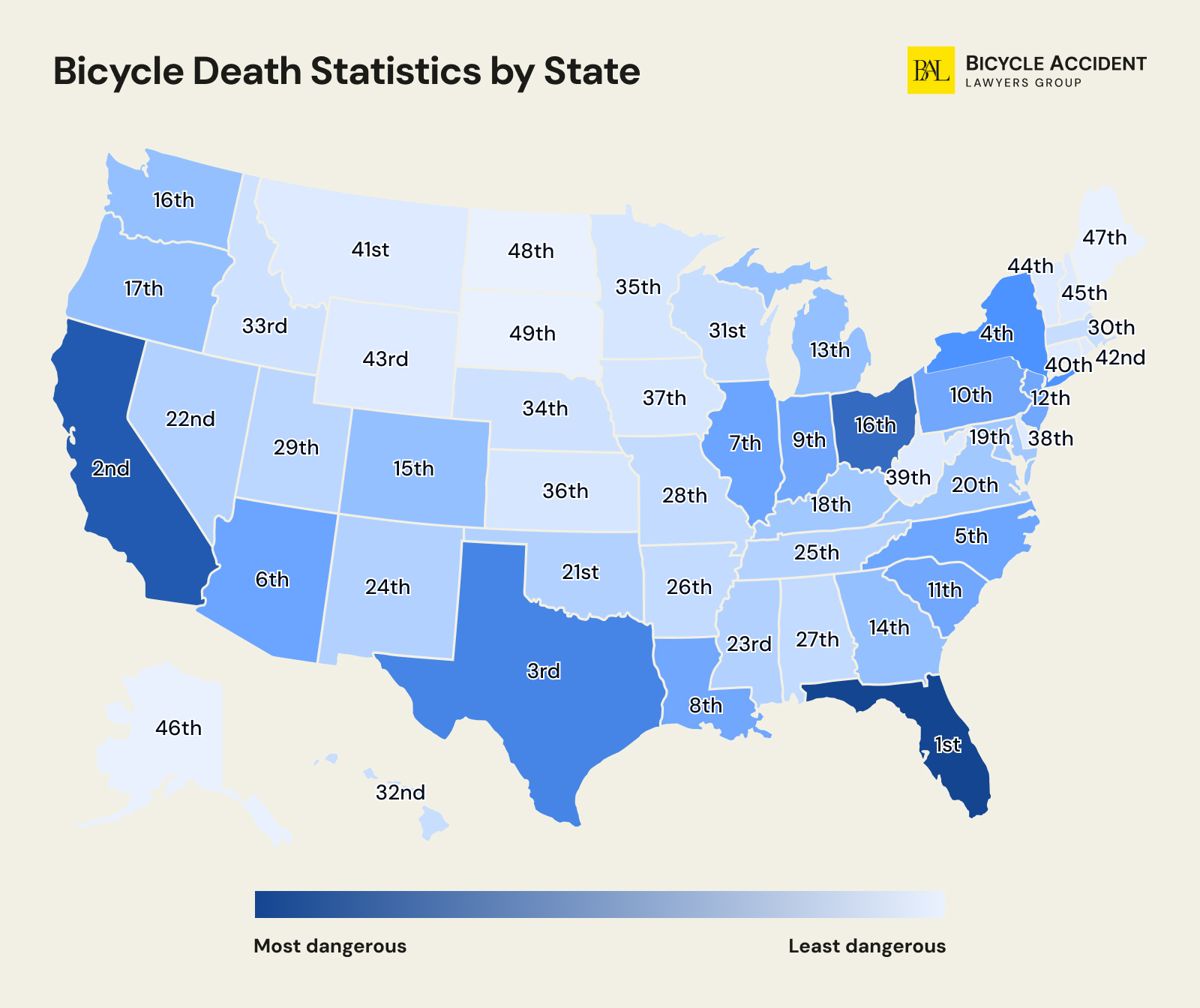
Washington, Massachusetts, and Oregon make the top 3 locations a bicyclist could dream of. However, not every state in the United States is that safe for bike riders. Nebraska, Missouri, and Mississippi are the three most dangerous states based on the local approach to infrastructure, funding, laws, and overall support of the cycling community, according to the recent bicycle-friendly state ranking.
Interestingly enough, bicyclist-friendly actions taken by the state don’t always guarantee a low fatality rate among cyclists. Both California and Florida belong to the top 10 safe places for cycling, yet they are the two states that featured the highest fatality rates among cyclists — 145 and 234 in 2023, respectively. At the same time, North Dakota and Montana are on the list of the most unfriendly states, yet there were 0 and 2 bicyclist casualties recorded in these states in 2023.
Although there aren’t official statistics for 2024 available at the moment, our comparative analysis indicates that the situation across the ‘deadliest’ states seems to be improving.
| State | 2022 | 2023 | 2024(*Estimate by the Bicycle Accident Lawyers Group, based on partial 2025 statistics and yearly trends) | |||||||
| Total Fatalities | Bicyclist Deaths | Total Fatalities | Bicyclist Deaths | Total Fatalities | Bicyclist Deaths | National rank | ||||
| Number | % of all Fatalities | Number | % of all Fatalities | Number | % of all Fatalities | |||||
| Alabama | 988 | 14 | 1.4% | 974 | 10 | 1.0% | 1,046 | 11 | 1.1% | #46 |
| Alaska | 82 | 2 | 2.4% | 60 | 0 | 0.0% | 61 | 2 | 2.8% | #34 |
| Arizona | 1,302 | 50 | 3.8% | 1,304 | 43 | 3.3% | 1,473 | 38 | 2.6% | #37 |
| Arkansas | 643 | 6 | 0.9% | 596 | 11 | 1.8% | 590 | 9 | 1.5% | #39 |
| California | 4,428 | 177 | 4.0% | 4,061 | 145 | 3.6% | 4,259 | 146 | 3.4% | #4 |
| Colorado | 764 | 15 | 2.0% | 720 | 20 | 2.8% | 792 | 19 | 2.4% | #6 |
| Connecticut | 359 | 3 | 0.8% | 308 | 4 | 1.3% | 338 | 4 | 1.1% | #13 |
| Delaware | 162 | 6 | 3.7% | 135 | 5 | 3.7% | 145 | 6 | 4.4% | #7 |
| Florida | 3,530 | 222 | 6.3% | 3,396 | 234 | 6.9% | 3,478 | 220 | 6.3% | #8 |
| Georgia | 1,797 | 29 | 1.6% | 1,615 | 24 | 1.5% | 1,644 | 27 | 1.7% | #23 |
| Hawaii | 116 | 7 | 6.0% | 93 | 8 | 8.6% | 100 | 9 | 8.9% | #25 |
| Idaho | 215 | 4 | 1.9% | 275 | 7 | 2.5% | 299 | 7 | 2.5% | #36 |
| Illinois | 1,268 | 35 | 2.8% | 1,241 | 41 | 3.3% | 1,288 | 38 | 2.9% | #11 |
| Indiana | 949 | 16 | 1.7% | 898 | 31 | 3.5% | 950 | 28 | 3.0% | #20 |
| Iowa | 338 | 4 | 1.2% | 377 | 5 | 1.3% | 418 | 1 | 0.1% | #24 |
| Kansas | 410 | 7 | 1.7% | 387 | 6 | 1.6% | 397 | 7 | 1.7% | #21 |
| Kentucky | 744 | 14 | 1.9% | 814 | 16 | 2.0% | 882 | 17 | 1.9% | #32 |
| Louisiana | 906 | 45 | 5.0% | 811 | 35 | 4.3% | 788 | 34 | 4.3% | #40 |
| Maine | 182 | 2 | 1.1% | 135 | 0 | 0.0% | 136 | 2 | 1.3% | #28 |
| Maryland | 564 | 10 | 1.8% | 621 | 15 | 2.4% | 702 | 17 | 2.4% | #9 |
| Massachusetts | 434 | 9 | 2.1% | 343 | 9 | 2.6% | 330 | 10 | 3.0% | #2 |
| Michigan | 1,124 | 36 | 3.2% | 1,094 | 24 | 2.2% | 1,157 | 21 | 1.8% | #10 |
| Minnesota | 444 | 6 | 1.4% | 409 | 6 | 1.5% | 399 | 3 | 0.9% | #5 |
| Mississippi | 703 | 17 | 2.4% | 732 | 13 | 1.8% | 768 | 11 | 1.4% | #50 |
| Missouri | 1,057 | 11 | 1.0% | 991 | 10 | 1.0% | 1,055 | 11 | 1.0% | #49 |
| Montana | 213 | 2 | 0.9% | 208 | 2 | 1.0% | 208 | 1 | 0.6% | #43 |
| Nebraska | 244 | 0 | 0.0% | 227 | 6 | 2.6% | 248 | 7 | 3.0% | #48 |
| Nevada | 416 | 15 | 3.6% | 389 | 14 | 3.6% | 422 | 17 | 4.0% | #38 |
| New Hampshire | 146 | 3 | 2.1% | 130 | 1 | 0.8% | 147 | 1 | 0.6% | #31 |
| New Jersey | 685 | 18 | 2.6% | 606 | 27 | 4.5% | 603 | 23 | 3.8% | #26 |
| New Mexico | 466 | 4 | 0.9% | 437 | 12 | 2.7% | 448 | 11 | 2.6% | #35 |
| New York | 1,175 | 50 | 4.3% | 1,114 | 49 | 4.4% | 1,178 | 52 | 4.4% | #15 |
| North Carolina | 1,630 | 22 | 1.3% | 1,561 | 46 | 2.9% | 1,629 | 46 | 2.8% | #17 |
| North Dakota | 98 | 1 | 1.0% | 106 | 0 | 0.0% | 117 | 1 | 0.7% | #41 |
| Ohio | 1,275 | 8 | 0.6% | 1,242 | 22 | 1.8% | 1,279 | 10 | 0.8% | #16 |
| Oklahoma | 710 | 15 | 2.1% | 718 | 15 | 2.1% | 751 | 15 | 2.0% | #42 |
| Oregon | 601 | 13 | 2.2% | 587 | 17 | 2.9% | 627 | 13 | 2.1% | #3 |
| Pennsylvania | 1,179 | 15 | 1.3% | 1,211 | 29 | 2.4% | 1,296 | 26 | 2.0% | #19 |
| Rhode Island | 52 | 0 | 0.0% | 71 | 2 | 2.8% | 81 | 2 | 2.1% | #18 |
| South Carolina | 1,094 | 25 | 2.3% | 1,047 | 25 | 2.4% | 1,048 | 23 | 2.2% | #47 |
| South Dakota | 137 | 3 | 2.2% | 140 | 0 | 0.0% | 147 | 3 | 2.0% | #45 |
| Tennessee | 1,314 | 15 | 1.1% | 1,323 | 11 | 0.8% | 1,425 | 13 | 0.9% | #29 |
| Texas | 4,408 | 91 | 2.1% | 4,291 | 106 | 2.5% | 4,516 | 96 | 2.1% | #30 |
| Utah | 319 | 15 | 4.7% | 280 | 9 | 3.2% | 276 | 11 | 4.1% | #14 |
| Vermont | 76 | 1 | 1.3% | 69 | 1 | 1.4% | 72 | 1 | 1.2% | #22 |
| Virginia | 1,008 | 11 | 1.1% | 913 | 15 | 1.6% | 952 | 11 | 1.2% | #12 |
| Washington | 733 | 11 | 1.5% | 810 | 18 | 2.2% | 949 | 16 | 1.7% | #1 |
| West Virginia | 264 | 2 | 0.8% | 260 | 4 | 1.5% | 270 | 5 | 1.9% | #33 |
| Wisconsin | 596 | 14 | 2.3% | 583 | 8 | 1.4% | 609 | 8 | 1.3% | #27 |
| Wyoming | 134 | 1 | 0.7% | 144 | 2 | 1.4% | 174 | 3 | 1.5% | #44 |
| US Total | 42,482 | 1,102 | 2.6% | 40,857 | 1,163 | 2.8% | 42,964 | 1,109 | 2.6% | |
10 Most Dangerous States for Cyclists
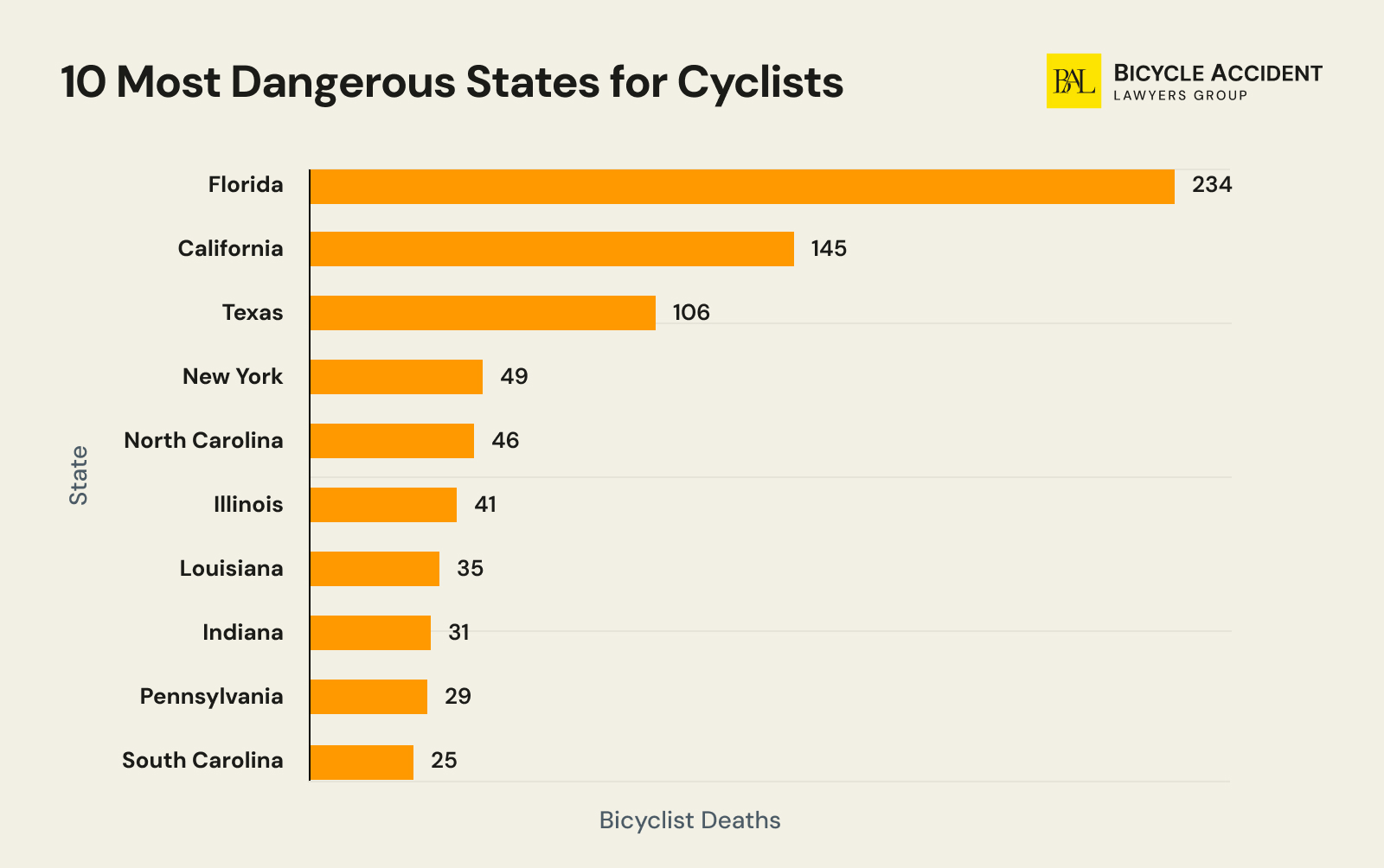
There isn’t a single factor that makes an area instantly unsafe for cycling. Usually, it takes several factors for the state to be viewed as quite dangerous for cyclists. Today, we’ll discuss the top 10 most dangerous states in the USA based on recent mortality rates among bicyclists.
Florida
Over 0.5% of people across Florida use their bicycles to get to work daily. Yet, more than two hundred bike riders die on local roads annually, and over and around 9K get serious injuries. That is one of the worst indicators in America. High-speed roads in the state are among the major contributing factors to such unfavorable stats. In 2024, Florida was ranked 8th on the National Bicycle Friendly State list, because of the local authorities’ efforts to improve the situation, but it remains grim.
California
A close neighbor of Florida — California — seems to deal with the same challenges when it comes to biking. As many as 145 cyclists sustained fatal traumas on the streets of sunny California in 2023. Although it seems like a favorable decrease in bicyclist deaths compared to past years, bike riders make up around 4% of all traffic fatalities across the state. There may be fewer road-rage-inspired accidents in California since almost 70% of other motorists believe that all cyclists have the right to share the road with them, but the area is still one of the most dangerous in the USA.
Texas
Texas holds the third place on the list of the least favorable locations for cycling. The increase in bicyclist mortality in 2023 made up almost 9% when compared to 2022. While that is one of the main reasons why Texas holds the 30th position in the national ranking, it is surely not the only one. Despite the alarming trends, state authorities continue to fail to invest funds into enhanced safety of the cycling community. To be precise, only once over the past 10 years, the state spent more than 2% of the federal funds on cycling and walking in 10 years.
New York
Over 4% of all traffic casualties in the state are bike riders. 49 bicyclist deaths were reported across New York in 2023. This data may be the main reason why NY did not hit the top 10 most bicycle-friendly states but held the 15th position on the nationwide ranking. According to recent reports, there has been a slight improvement in cycling safety across the state — most cities have adopted the 20-25 mph speed limit.
However, as little as $3.20 per capita is spent on improving existing infrastructure and developing new bicyclist-oriented projects in New York. Moreover, unlike other states, New York still does not have the safe-passing law, which also puts pedalcyclists at serious risk.
North Carolina
North Carolina isn’t listed as one of the top 10 states in the USA, and there’s a good reason for that. The number of bicycle crashes that took place across the state increased by an alarming 100% between 2022 and 2023. 46 were fatally injured on local roads, and that is almost 3% of all traffic casualties recorded across the state. NC State Police admit to the existing problems, and governmental authorities seem to be willing to spend over 2% of federal funding on vulnerable user safety, which brings hope.
Illinois
The state of Illinois holds the 11th position on the national bicyclist-friendly rank. The number of businesses, universities, and communities that support biking is impressive, as are the scenic trails across the state. However, the lack of sufficient investments in safe riding infrastructure — with only 1/3 of highway routes fit for cycling purposes — along with high-speed limits inevitably leads to numerous traffic deaths that involve cyclists. In 2023, 41 people died while riding their bikes, and that is as many as over 3% of all fatal incidents across the state.
Louisiana
Back in 2023, 35 cyclists were killed while riding their bikes. The survey states that the numbers dropped by over 20%. However, the alarming number of people dying on the streets of Louisiana because of a tragic accident clearly indicates that the state still holds its “most dangerous” position.
Moreover, not only do the death rates remain concerning, but the possibility of getting severely injured in an accident reached its 5-year spike. Louisiana ranked 40th, with only two bicycle-friendly communities and just one cyclist-friendly business. There are no state-approved urban area speed limits. That, combined with insufficient industry funding, results in such concerning stats.
Indiana
31 bike riders were fatally injured on the roads of Indiana in 2023. The absence of a statewide improvement plan may be one of the underlying reasons why there are so many casualties among vulnerable road users in Indiana.
One more upsetting indicator of how unsafe the streets of the state are would be the fact that children between 10 and 14 years old sustained the most serious traumas from all the injured cyclist groups in the state. On a slightly brighter note, it is worth admitting that the state has created an annual fund aimed at sidewalk reconstruction to improve the overall safety of vulnerable road user categories.
Pennsylvania
The Pennsylvania government seems to be struggling with prioritizing biking and walking projects. This is one of the reasons why the state is listed as 19th on the Bicycle-Friendly State report. Moreover, Pennsylvania is losing its position, and that is reflected in growing fatality rates among cyclists.
In 2023, 29 people were killed in biking accidents, and that was an almost 100% spike when compared to data gathered in 2022. On top of that, local municipalities do not rush to implement low-speed limits in the area to at least try to improve the situation.
South Carolina
Over the past two years, the bicyclist fatality rate in South Carolina has not seemed to change much. However, Charleston, Horry, Greenville, and Beaufort counties prove to be the most dangerous across the state. In 2023, 25 cyclists were fatally injured in South Carolina, and in almost 40% of all car accidents, the motorists failed to detect the riders. This can only mean that the speed limits in the state are still too high, and the number of designated lanes remains low. South Carolina holds 47th place in a state rank and accounts for as many as 45 fatalities per 10K commuters.
10 Safest States for Cyclists
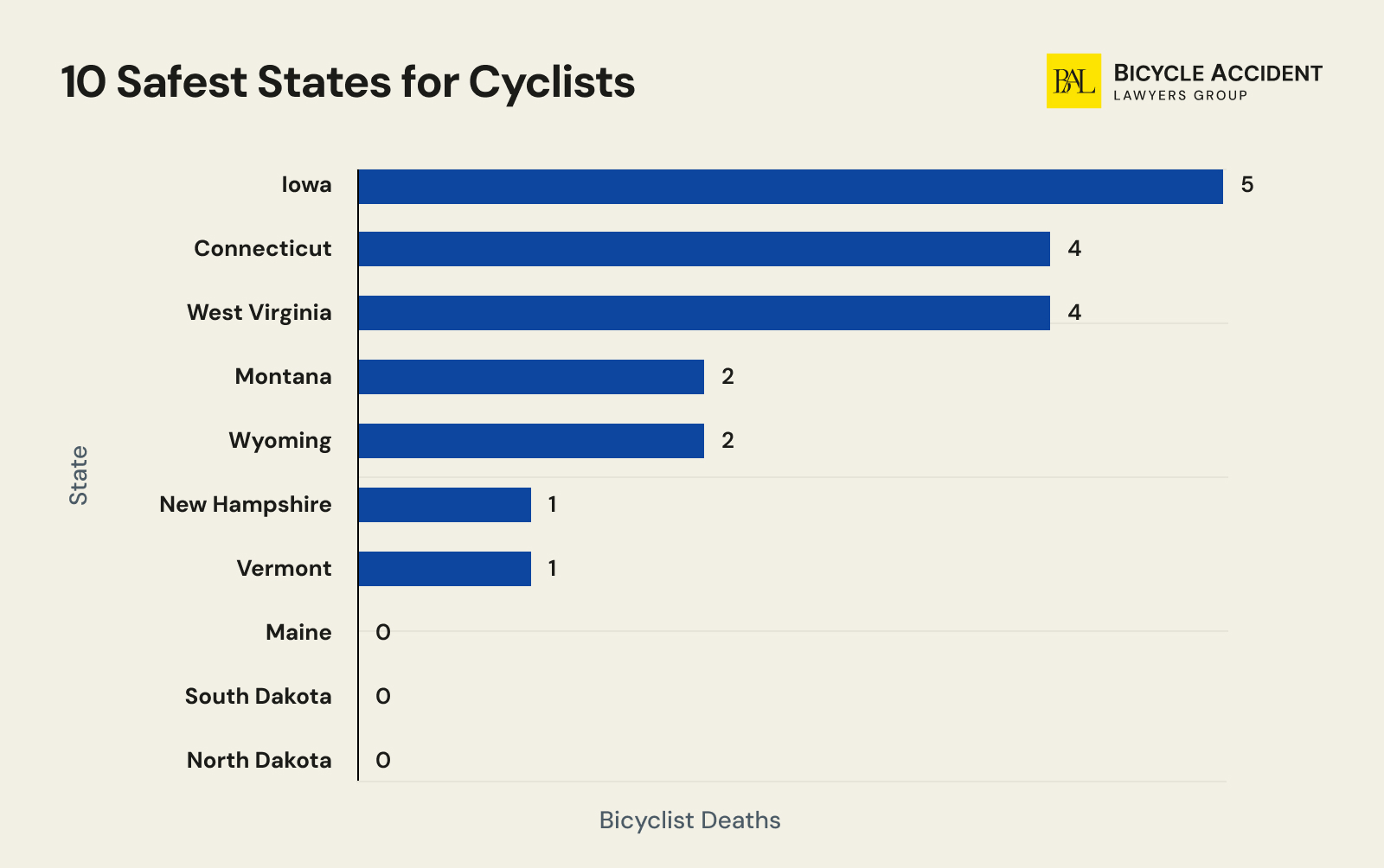
The ultimate safety of a state includes a variety of aspects. This ranges from governmental efforts and proper investment to people’s awareness of such vulnerable road user categories as cyclists. Although it may seem partially subjective, the lower the mortality rate in the area, the friendlier it appears to be.
North Dakota
North Dakota can be titled the safest state for cyclists in the USA. According to recent reports, no people died in bike crashes in 2023. While it was granted 41st position on the national rank, the community spends over $4.95 per capita on walking and bike riding in the state. Not to mention that flat roads and a wide range of rural areas contribute to cyclist safety in North Dakota. All that considered, the state has one of the lowest rates of bicycle-related accidents in the country — 0.2 per 100K of citizens yearly.
South Dakota
The state holds the second place on the list of the safest locations across the country since there were zero fatal incidents recorded in 2023. While the state spends around $5.17 per capita on walking and biking, it is one of the states that hasn’t adopted a statewide biking plan. Once they do so, they will receive additional investments, which will make the riding conditions even safer.
Maine
From 2019 to 2023, there were only 8 bicyclist deaths recorded in Maine, which made up less than 1% of all traffic collisions across the state. As of 2024, Maine holds the 28th place on the national rank. The state is working on new laws and regulations that will enhance the overall safety of vulnerable road users and provide them with unique rights in case of an accident. Although the cycling community is still at risk, the government entities are working to improve existing riding conditions.
Vermont
According to the recent data, only one cyclist died on Vermont roads in 2023, and that is an impressive accomplishment that the state can be proud of. In fact, there’s little wonder why — Vermont is one of the few states that has adopted a 4-feet safe passing rule.
Moreover, local funding reached $10.79 per capita spent on walking and biking in the area. Vermont holds the 22nd national rank, but the data indicate that it may deserve a higher ranking.
New Hampshire
Although New Hampshire hasn’t been deemed the safest state for cycling, it seems to be moving in the right direction. In 2023, only one rider was fatally injured on the streets of New Hampshire. That same year, the state adopted a biking plan that includes over 2,000 miles of bikeways and 700 miles of dedicated trails.
On top of that, local authorities pay a lot of attention to surveys that reflect the current situation in the area and point out sufficient measures to make New Hampshire available for all road user groups.
Wyoming
One may rightfully assume that the low population density of Wyoming is the primary reason why there are fewer cyclist fatalities in the area. However, other attributing factors ensure biker safety on local roads. For instance, as many as 25% of bicyclists involved in crashes wore protective helmets in urban areas.
Moreover, 50% of all riders in rural areas tend to wear a helmet while riding. The precaution may save a rider from a deadly outcome any day. Although local authorities could have spent more on cycling infrastructure in the state, the stats speak for themselves.
Montana
Two fatal bike accidents were recorded across Montana in 2023. That is one of the lowest mortality indicators among cyclists across the USA. Surely, the state can’t show off the extreme density of the population, but as many as 1% of Montana’s citizens use their bicycles to get to work.
With that in mind, 18 communities across the state have applied for and received safety grants that aim to eliminate deadly traffic incidents. Moreover, Montana State University is conducting valuable research in the field of traffic safety culture and rural road safety, which achieves the goal.
West Virginia
The seemingly challenging, mountainous terrains of West Virginia make people assume that bicyclist deaths are thriving in the area. However, the statistics prove otherwise. Over the past few years, the state has risen on the national bicycle-friendly list and proudly holds the 30rd position as of 2024. The interest that the local authorities, along with the community in general, have in vulnerable user safety deserves attention.
Seven communities across the state received grants aimed at cyclist safety. Moreover, over the past two years, the state government has spent a record amount of federal funding on the improvement of bicycling and walking safety.
Connecticut
There is more than a single reason why Connecticut holds 13th place on the national bicycle-friendly state rank. Although there were four bicyclist deaths reported in the state in 2023, the state authorities continue to regularly invest in various programs that promote vulnerable user safety. For instance, they give out $5K grants to communities to hold multiple educational events that are related to the topic. In the first year of the initiative implementation, over 60 organizations took part in those programs. Such an approach to cycling and walking is reflected in low mortality rates among vulnerable user groups.
Iowa
Iowa closes our list of the top 10 safest places for bike riding in the USA. Over the past few years, the state has been increasing federal investments in cycling safety, and it seems to be paying off. There were only 5 bicyclist deaths recorded in 2023 in the area, which made up 1.3% of all traffic fatalities. The state authorities passed the Crosswalk Protection Bill aimed at cyclist protection but didn’t pass the 3-feet passing rule, which could have had its toll on the recorded death rate.
Bicycle Death Statistics by City
The recent NHTSA report proves that some cities located in the most bicyclist-friendly states of America may still be quite unsafe for bicyclists.
- In Sacramento, CA, bicyclist fatalities made up over 11% of all deadly crashes.
- In Los Angeles, CA, 10 cyclists were killed in an accident in 2023.
- In Charlotte, NC, Nashville, TN, and Memphis, TN, there were fewer than 1% of registered cyclists’ deaths in 2023.
- Fort Worth, TX, and El Paso, TX, had zero bike rider deaths recorded in 2023.
- Cyclist fatalities across major cities in the USA made up around 14% of all pedal cyclists’ deaths across the country in 2023.
According to our comparative analysis, the rates of cyclist deaths across the largest cities of the USA showcase an overall favorable decrease.
| City | 2023 | 2024 | Difference | Percent Change | ||||
| Total Fatalities | Bicyclist Deaths | Percentage of Total Fatalities | Total Fatalities | Bicyclist Deaths | Percentage of Total Fatalities | |||
| Albuquerque, NM | 109 | 3 | 2.8% | 114 | 2 | 2.0% | -1 | -26% |
| Austin, TX | 94 | 5 | 5.3% | 110 | 3 | 3.0% | -2 | -43% |
| Baltimore, MD | 46 | 1 | 2.2% | 47 | 1 | 2.1% | 0 | -1% |
| Boston, MA | 18 | 1 | 5.6% | 25 | 1 | 4.1% | 0 | -27% |
| Charlotte, NC | 89 | 1 | 1.1% | 100 | 2 | 1.5% | 1 | 34% |
| Chicago, IL | 167 | 7 | 4.2% | 197 | 9 | 4.7% | 2 | 13% |
| Columbus, OH | 98 | 3 | 3.1% | 96 | 2 | 2.4% | -1 | -21% |
| Dallas, TX | 207 | 5 | 2.4% | 221 | 4 | 2.0% | -1 | -19% |
| Denver, CO | 76 | 2 | 2.6% | 73 | 2 | 3.2% | 0 | 22% |
| Detroit, MI | 131 | 3 | 2.3% | 134 | 4 | 2.7% | 1 | 19% |
| El Paso, TX | 84 | 0 | 0.0% | 79 | 2 | 2.5% | 2 | 100% |
| Fort Worth, TX | 118 | 0 | 0.0% | 122 | 4 | 2.9% | 4 | 100% |
| Fresno, CA | 52 | 1 | 1.9% | 66 | 3 | 5.1% | 2 | 163% |
| Houston, TX | 296 | 16 | 5.4% | 319 | 13 | 4.1% | -3 | -25% |
| Indianapolis, IN | 120 | 6 | 5.0% | 133 | 5 | 3.8% | -1 | -25% |
| Jacksonville, FL | 164 | 6 | 3.7% | 164 | 6 | 3.4% | 0 | -6% |
| Kansas City, MO | 98 | 3 | 3.1% | 88 | 3 | 2.8% | -1 | -8% |
| Las Vegas, NV | 42 | 1 | 2.4% | 42 | 2 | 3.5% | 1 | 49% |
| Los Angeles, CA | 329 | 10 | 3.0% | 338 | 14 | 4.1% | 4 | 36% |
| Louisville, KY | 118 | 4 | 3.4% | 114 | 4 | 3.8% | 0 | 12% |
| Memphis, TN | 244 | 2 | 0.8% | 237 | 2 | 1.0% | 0 | 20% |
| Mesa, AZ | 69 | 7 | 10.1% | 64 | 4 | 6.3% | -3 | -38% |
| Milwaukee, WI | 79 | 3 | 3.8% | 78 | 3 | 3.8% | 0 | 1% |
| Nashville, TN | 110 | 1 | 0.9% | 113 | 2 | 1.3% | 1 | 46% |
| New York, NY | 204 | 22 | 10.8% | 231 | 17 | 7.2% | -5 | -33% |
| Oklahoma City, OK | 101 | 2 | 2.0% | 96 | 3 | 3.1% | 1 | 57% |
| Philadelphia, PA | 135 | 9 | 6.7% | 137 | 6 | 4.6% | -3 | -30% |
| Phoenix, AZ | 308 | 7 | 2.3% | 303 | 12 | 4.0% | 5 | 74% |
| Portland, OR | 69 | 2 | 2.9% | 65 | 3 | 4.6% | 1 | 60% |
| Sacramento, CA | 69 | 8 | 11.6% | 72 | 5 | 7.4% | -3 | -36% |
| San Antonio, TX | 178 | 8 | 4.5% | 194 | 7 | 3.8% | -1 | -16% |
| San Diego, CA | 94 | 2 | 2.1% | 110 | 3 | 2.7% | 1 | 28% |
| San Francisco, CA | 34 | 1 | 2.9% | 36 | 1 | 2.8% | 0 | -5% |
| San Jose, CA | 61 | 2 | 3.3% | 67 | 4 | 5.5% | 2 | 68% |
| Seattle, WA | 35 | 1 | 2.9% | 40 | 2 | 5.9% | 1 | 106% |
| Tucson, AZ | 147 | 8 | 5.4% | 134 | 8 | 6.0% | 0 | 9% |
| Washington, DC | 44 | 3 | 6.8% | 39 | 3 | 7.7% | 0 | 13% |
Bicycle Death Statistic by Month
Seasonal changes have a significant impact on cyclist fatality rates as well. For instance, summer and autumn account for almost 60% of all cyclist deaths recorded across the country in 2023. Such an alarming spike may be explained by the increased interest in this recreational activity during these months.
At the same time, decreased bicyclist congestion during winter and spring equals lower death rates. An in-depth comparison of seasonal fatality trends across the country shows that the trends in 2024 remain consistent with the previous year, with an approximate deviation within 1-2%.
| Month | 2023 | 2024 | ||
| Fatalities | Percentage | Fatalities | Percentage | |
| January | 85 | 7 | 89 | 8 |
| February | 64 | 6 | 55 | 5 |
| March | 73 | 6 | 55 | 5 |
| April | 80 | 7 | 78 | 7 |
| May | 89 | 8 | 89 | 8 |
| June | 81 | 7 | 67 | 6 |
| July | 129 | 11 | 122 | 11 |
| August | 111 | 10 | 100 | 9 |
| September | 132 | 11 | 133 | 12 |
| October | 132 | 11 | 133 | 12 |
| November | 92 | 8 | 100 | 9 |
| December | 87 | 8 | 100 | 9 |
| Total | 1,155 | 1,109 | ||
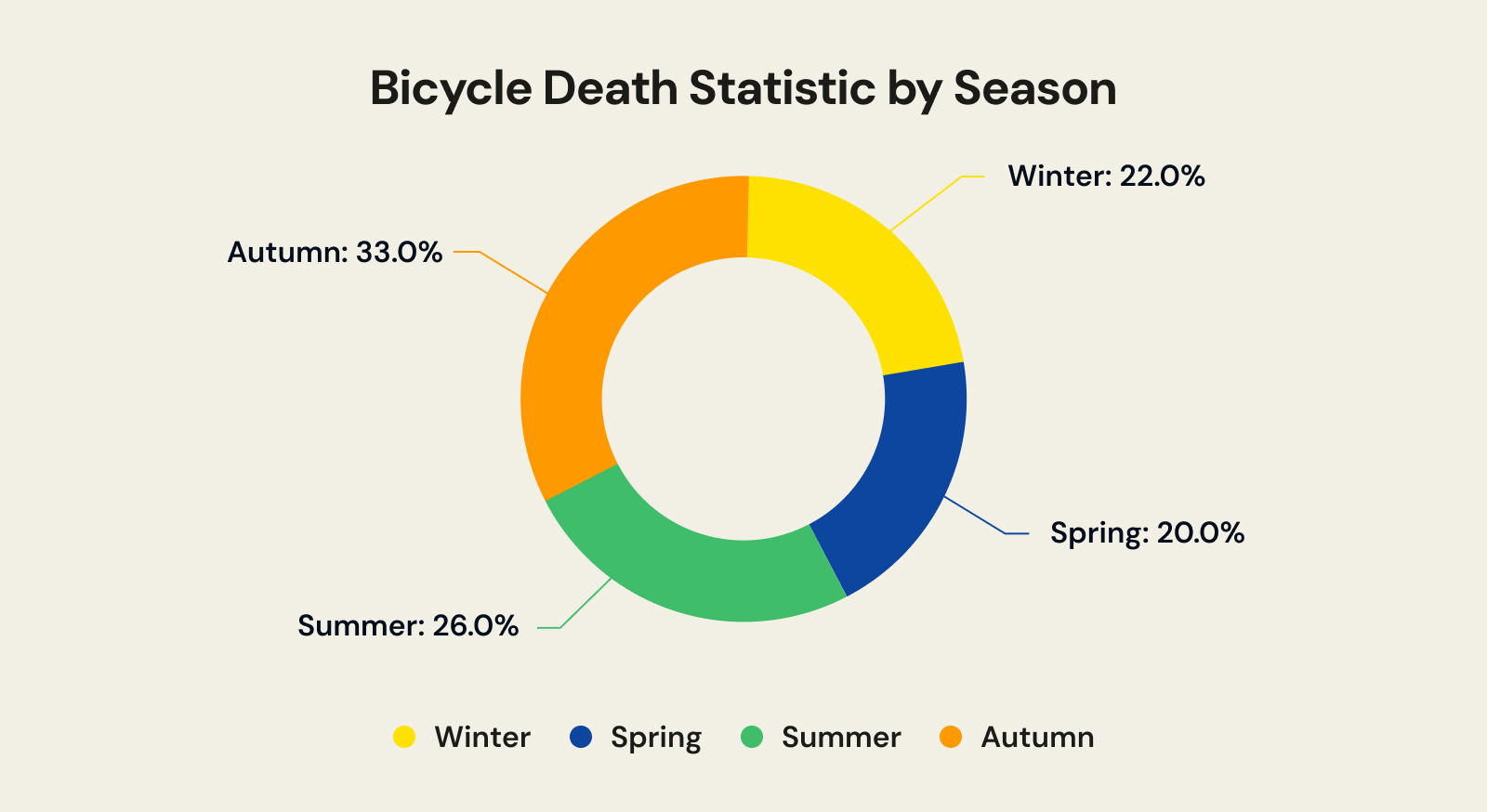
Bicycle Death Statistic by Time
According to the most recent reports from NHTSA, most fatal incidents took place in broad daylight. The 2024 forecast reflects similar trends, with barely noticeable shifts toward darker hours of the day — 43% as opposed to 41.6%. However, even such an insignificant change in dark-time fatality rate may emphasize the pressing need for improvement of lighting infrastructure throughout the country.
| Time of Day | 2023, % | 2024, % |
| Dusk | 3 | 3 |
| Dawn | 3 | 2 |
| Darker hours of the day | 42 | 43 |
| Daylight | 53 | 52 |
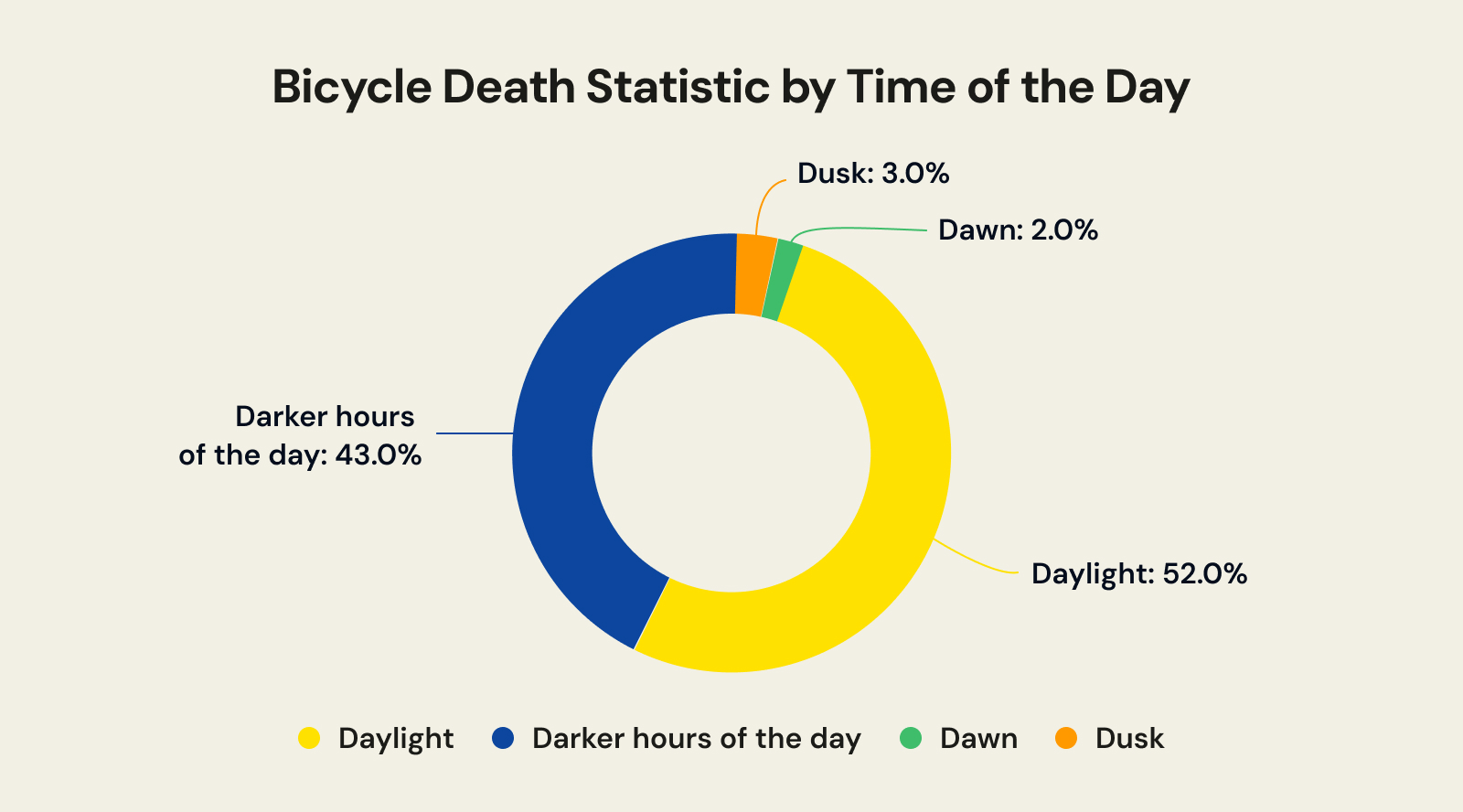
Bicycle Death Statistic by Location Type
Back in the day, there was little difference as to whether the accident happened in urban or rural areas; the stats were primarily equal, around 50%. However, nowadays, the data tells a different story:
- 19% of bicyclists got deadly injuries in rural areas.
- 81% of cyclists were killed in urban areas.
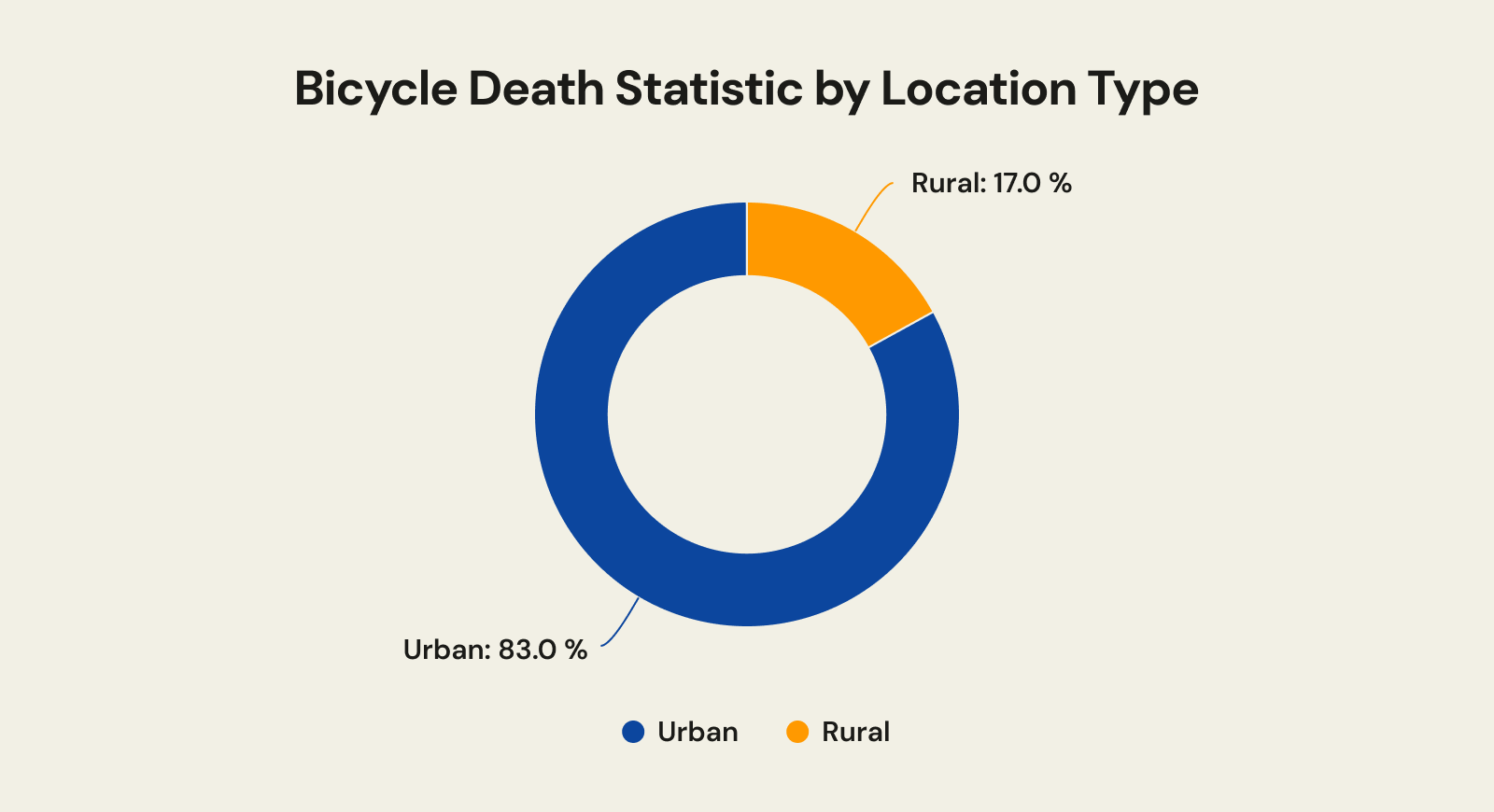
The fact that 8 out of 10 cyclists died within the city grounds does not mean that every part of it is equally dangerous. Some locations pose a greater threat to vulnerable road users, such as bicyclists. According to the 2023 data:
- 750 cyclists lost their lives on major roads.
- 347 people were fatally injured while riding bikes on minor roads.
- 44 bike riders died on interstates and freeways.
| Type of Road | 2023, % | 2024, % |
| Interstates | 4 | 4 |
| Major roads | 65 | 65 |
| Minor roads | 30 | 31 |
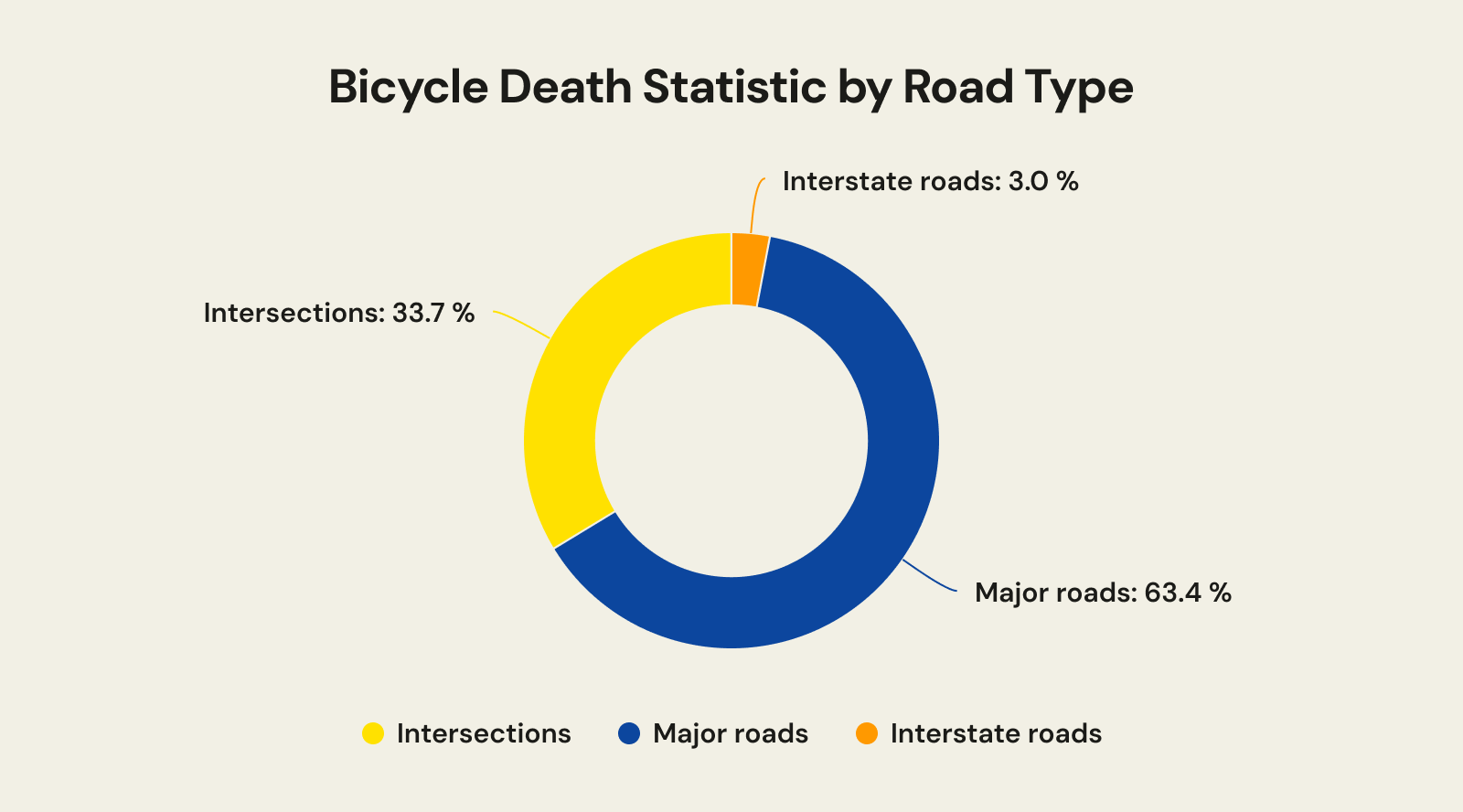
Bicycle Death Statistic by Age and Sex
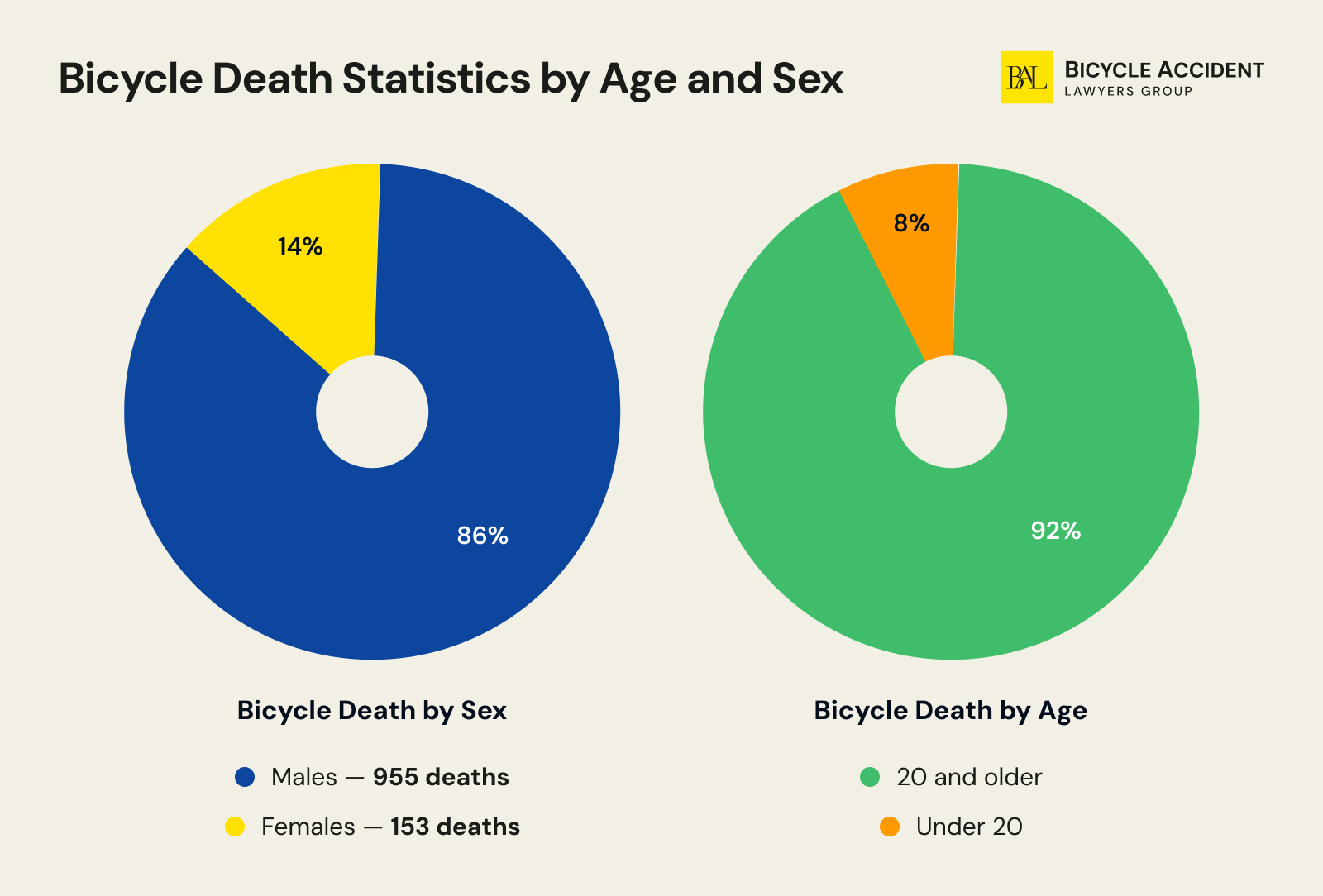
As it turns out, age and sex play a major part in the bicyclist fatality rate. According to a recent survey from NHTSA, males are more frequent victims of deadly bicycle collisions than females.
- 77-80% of male cyclists get fatally injured on an annual basis.
- Female riders’ deaths dropped by 1% in 2023, but made up 12% of all bicyclists killed nationwide in 2024.
- Fatalities among younger cyclists remain consistently low, rarely exceeding 10% for males and 2% for females.
Our current analytical insights state that new cycling safety strategies that prioritize adult riders have to be implemented.
| Year | <20 years | ≥20 years | Total* | |||||||
| Males | Females | Males | Females | |||||||
| Number | % | Number | % | Number | % | Number | % | Number | % | |
| 2021 | 96 | 10 | 28 | 3 | 733 | 76 | 93 | 10 | 965 | 100 |
| 2022 | 131 | 12 | 26 | 2 | 815 | 74 | 120 | 11 | 1,105 | 100 |
| 2023 | 64 | 5 | 24 | 2 | 920 | 79 | 115 | 10 | 1,166 | 100 |
| 2024 | 65 | 6 | 22 | 2 | 890 | 80 | 131 | 12 | 1,109 | 100 |
Bicycle Death Statistic by Helmet Use
There are no federal laws stating that every bicyclist must wear a protective helmet while riding their bike. In the majority of states across the USA, children between 14 and 17 years must wear helmets at all times, but most of the rules do not apply to adults, except in cases where local ordinances state otherwise.
- 14% of cyclists were wearing a protective helmet at the time of a deadly incident in 2023.
- Over 62% of fatally injured bike riders weren’t wearing protective helmets.
- 50% of severe head injuries that a cyclist may sustain happen due to the absence of a protective helmet.
- 21% of males are prone to wear a helmet.
- 28% of female riders wear helmets.
Our 2024 forecast reflects consistent fatality rate patterns, which suggest that stronger public awareness campaigns, stricter helmet law enforcement, and community-based safety programs are required to improve these cyclist fatality trends.
| Helmet Use | 2021, % | 2022, % | 2023, % | 2024, % |
| With helmet | 15 | 15 | 14 | 15 |
| No helmet | 62 | 62 | 62 | 62 |
| Unknown | 24 | 22 | 23 | 23 |
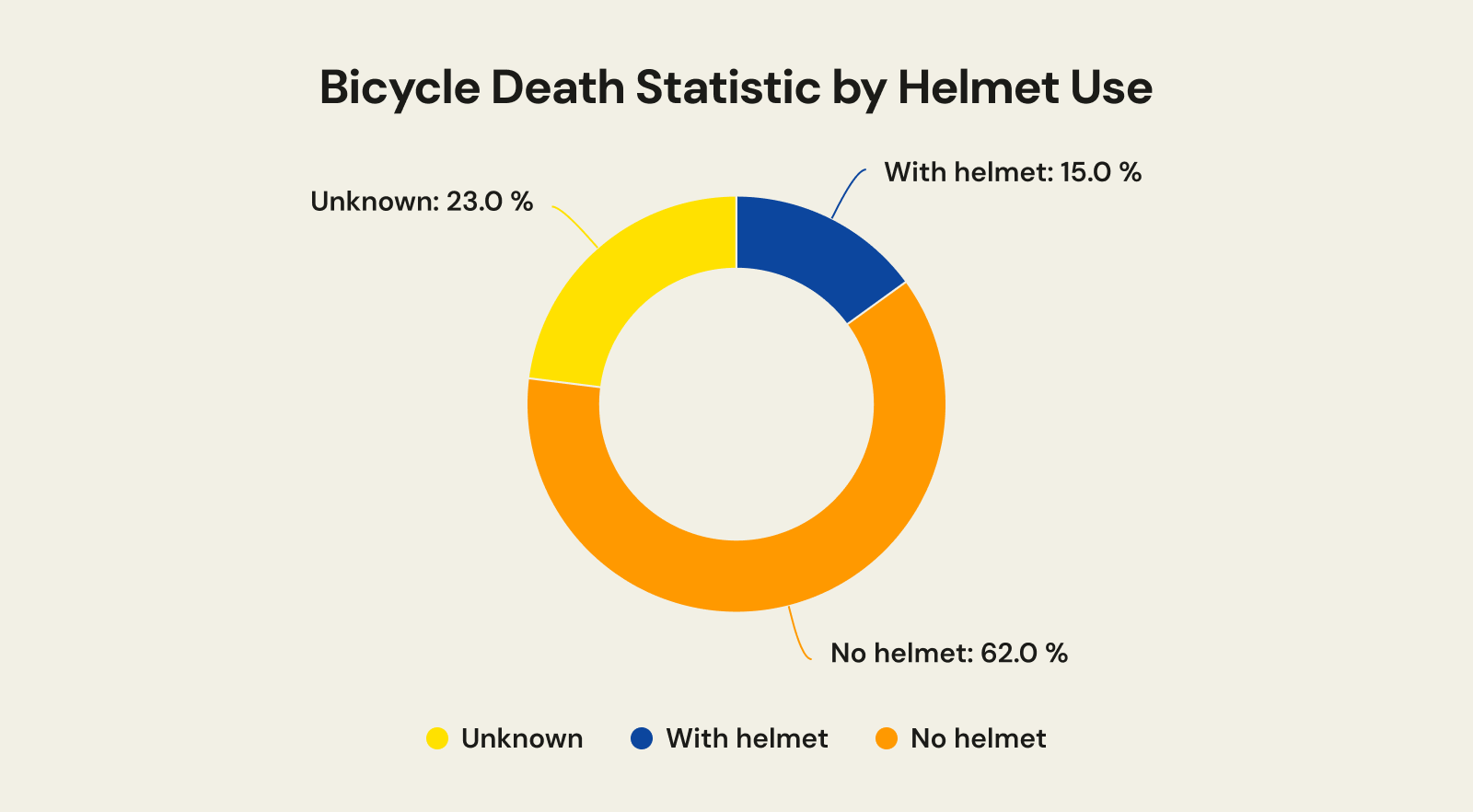
Bicycle Death with Alcohol in Blood Statistics
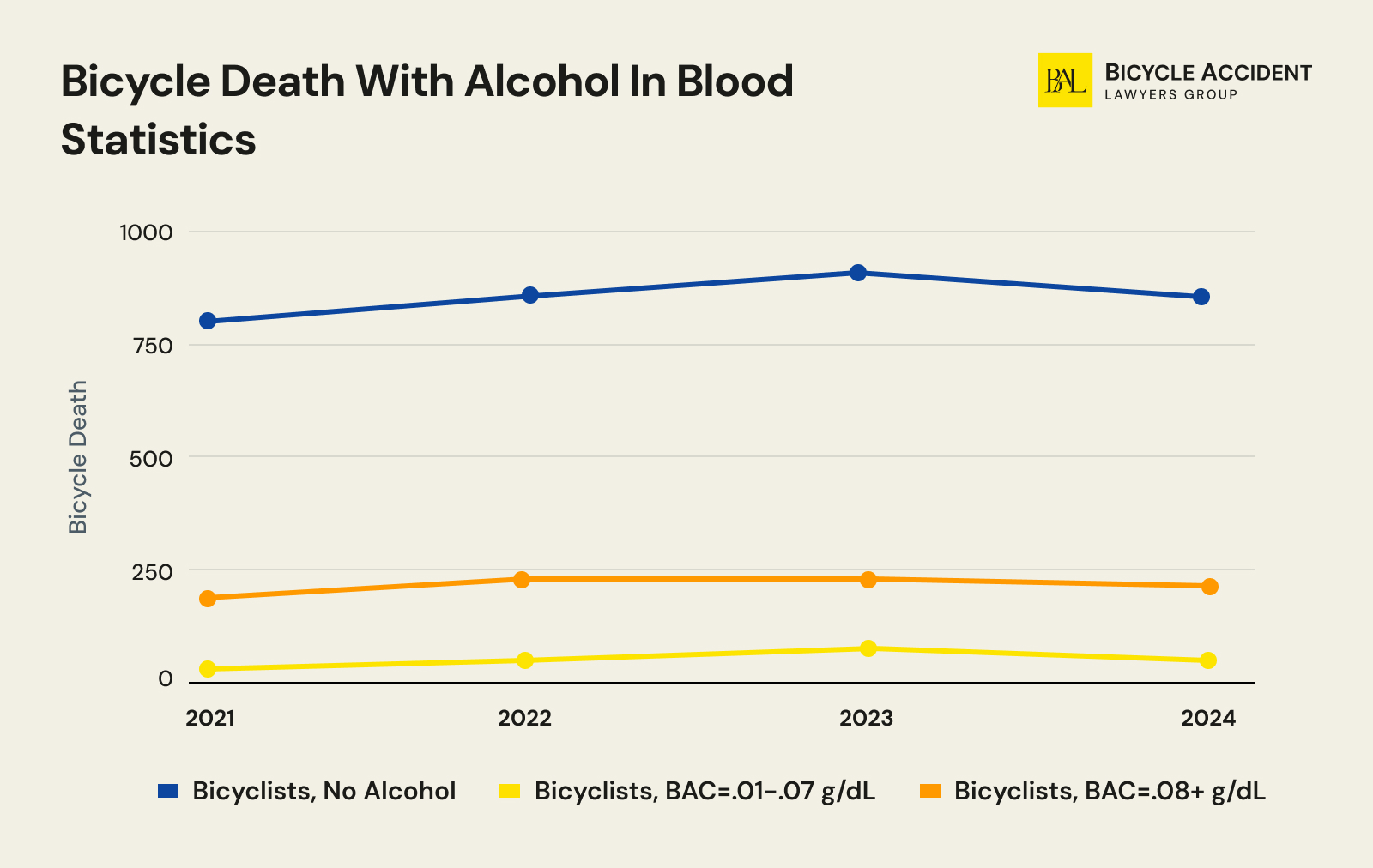
Most of the states in America have an approved blood alcohol concentration threshold that every vehicle user has to abide by. It is illegal to drive with a BAC of .08 g/dL and over everywhere else except for Utah. In Utah, the threshold was decreased to .05 g/dL.
- Over 78% of fatal bike accidents involved a sober cyclist in 2023.
- Around 18% of fatally injured bicyclists had a BAC of .08 g/dL detected in their system.
- 3% of deadly collisions involved an impaired driver and an impaired bicyclist.
- The overall percentage of intoxicated bike riders was over 22% in 2023.
Our 2024 predictive analysis indicates that the percentage of impaired bikers on the streets of the USA dropped by at least 1%.
| Bicyclists’ condition | 2021 | 2022 | 2023 | 2024 |
| Bicyclists, No Alcohol | 766 | 849 | 910 | 842 |
| Bicyclists, BAC=.01-.07 g/dL | 24 | 33 | 39 | 32 |
| Bicyclists, BAC=.08+ g/dL | 175 | 215 | 213 | 201 |
| % of Alcohol-Impaired Cyclists | 21% | 23% | 22% | 21% |
| Total | 965 | 1,097 | 1,162 | 1,109 |
Bicycle Death Statistics by Point of Impact
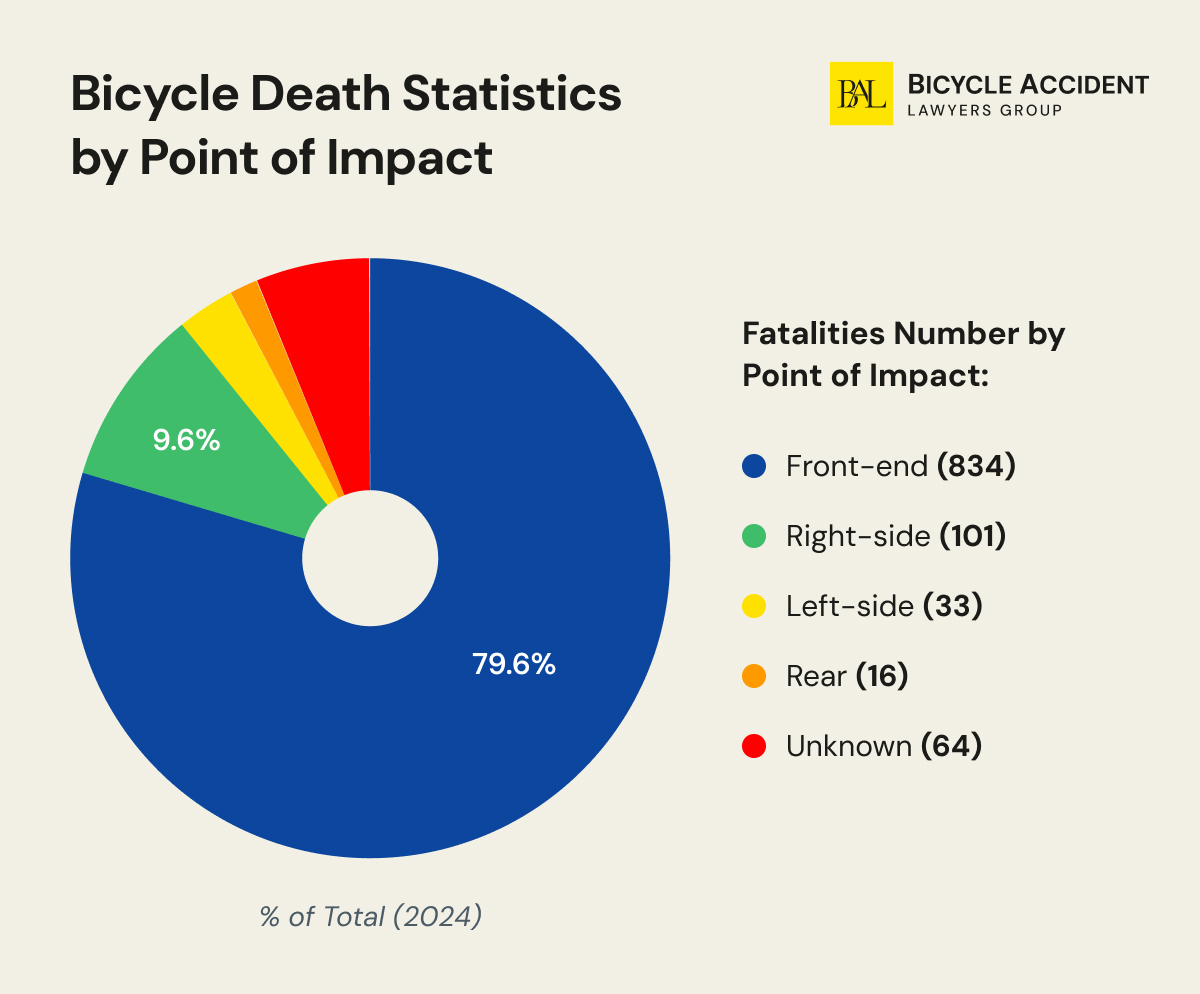
According to the most recent data, on average, 283 bike riders were killed in hit-and-run collisions, and 3% of bicyclists were fatally injured by distracted drivers. In terms of the type of collision, the data reflects the following trends:
- Around 82% of cyclists died in front-end collisions.
- 7.9% of right-side crashes between bicyclists and other motorists resulted in a fatal outcome.
- 2.5% of left-side collisions were deadly to pedal cyclists.
- 1.3% of rear-end crashes had lethal outcomes.
| Point of impact | 2021 | 2022 | 2023 | 2024 |
| Front-end | 756 | 853 | 898 | 834 |
| Left-side | 19 | 28 | 27 | 33 |
| Right-side | 52 | 64 | 86 | 101 |
| Rear | 11 | 14 | 14 | 16 |
| Unknown | 74 | 76 | 66 | 64 |
| Total | 912 | 1,035 | 1,091 | 1,048 |
Bicycle Death Statistics by Vehicle Type
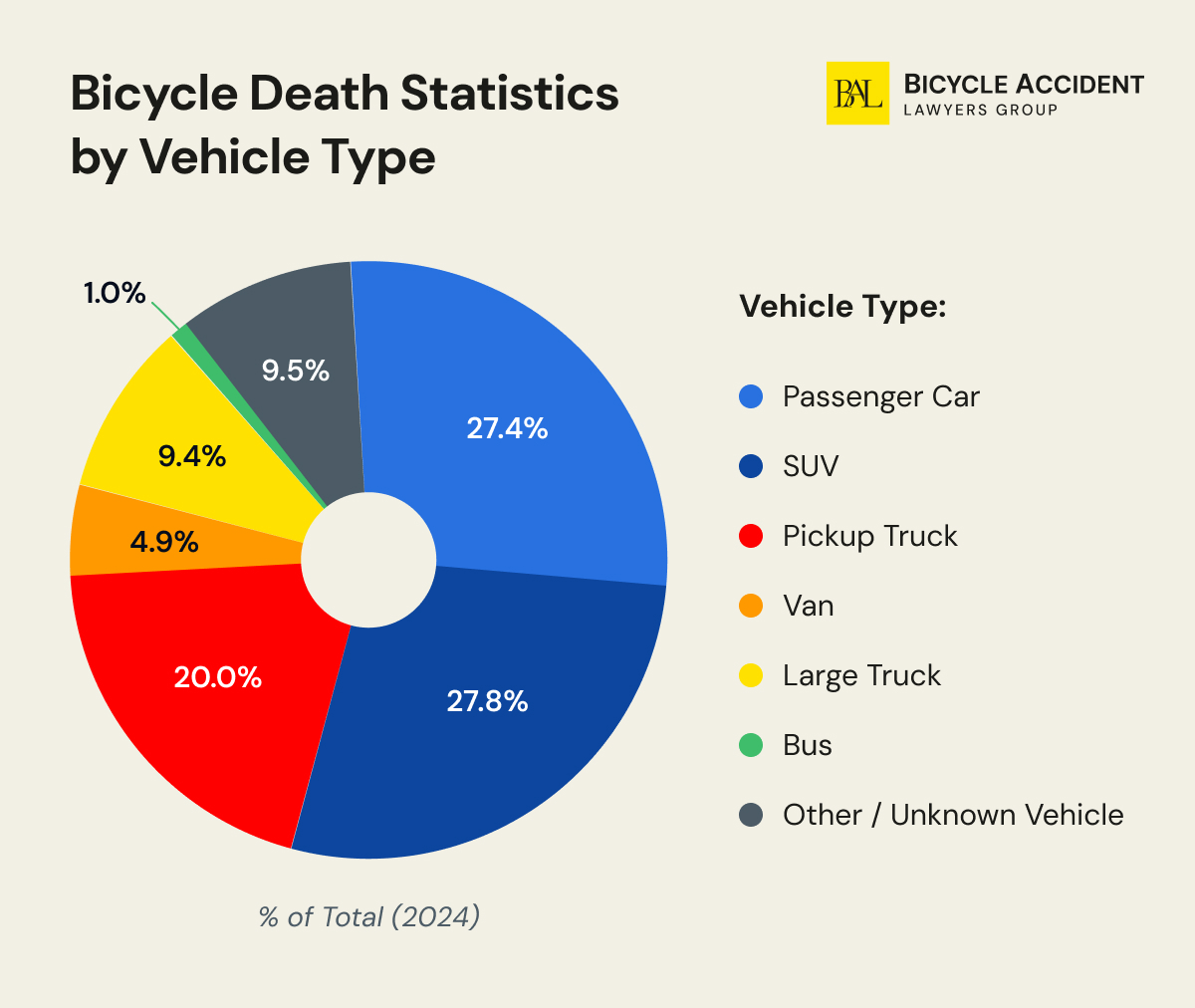
Every motor vehicle poses a danger to an average bicyclist. The size, speed, and force of impact brought upon a cyclist often lead to fatal injuries. According to the recent data from NHTSA, buses are the least dangerous of all the vehicles on the streets in terms of bicyclists’ safety.
- 323 bicyclists were killed by drivers of passenger cars in 2023.
- SUVs are the second most dangerous vehicle; 288 cyclists died from collisions with SUVs in 2023.
- Pickups and large trucks held the third and fourth places when it came to deadly bicycle accidents.
- 11 bike riders died in 2023 from bus collisions.
| Vehicle Type | 2021 | 2022 | 2023 | 2024 |
| Passenger Car | 316 | 320 | 323 | 287 |
| SUV | 204 | 248 | 288 | 291 |
| Pickup | 180 | 214 | 216 | 210 |
| Van | 37 | 37 | 53 | 51 |
| Large Truck | 65 | 107 | 89 | 98 |
| Bus | 6 | 5 | 11 | 11 |
| Other/Unknown Vehicle |
104 | 104 | 111 | 100 |
| Total | 912 | 1,035 | 1,091 | 1,048 |
Effective Ways to Decrease Bicyclist Fatality Rates in the USA
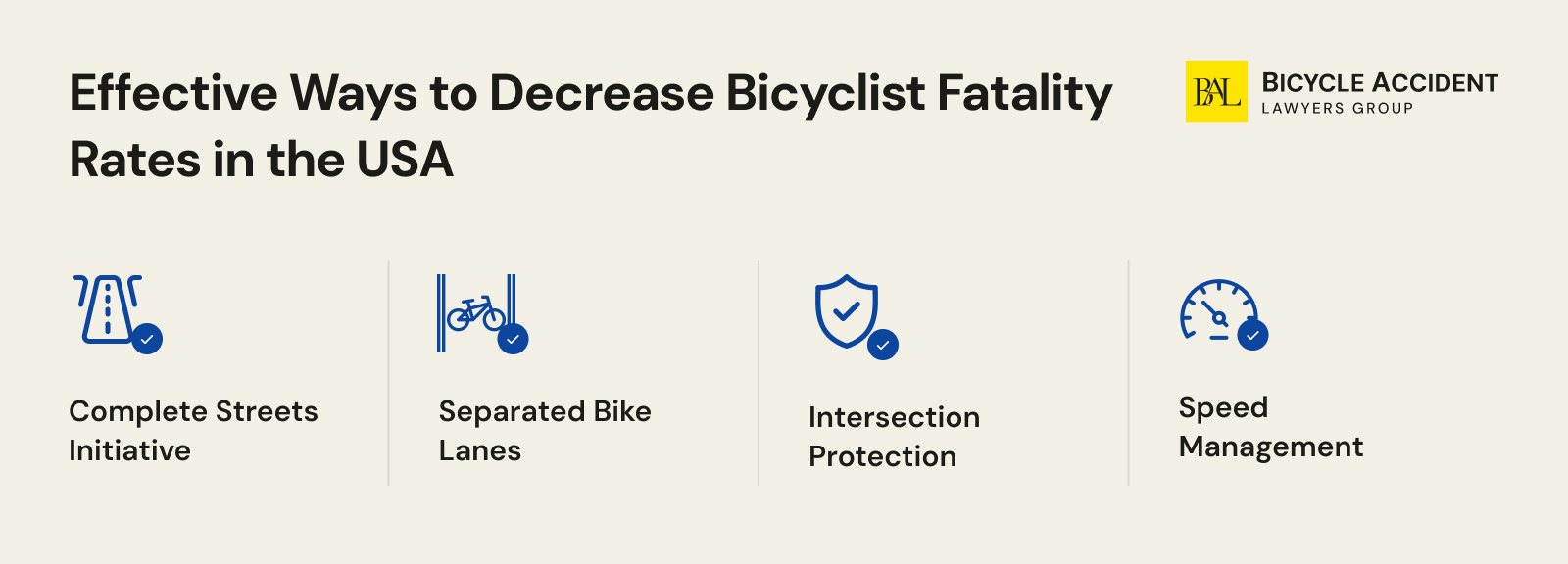
Pedalcyclists make a critical part of the vulnerable road users category and usually can’t stand a chance against a speeding vehicle. However, there are a few things that the Department of Transportation can do to improve the overall safety of this road user group.
Pedal cyclists make up a critical part of the vulnerable road users category and usually can’t stand a chance against a speeding vehicle. However, there are a few things that the Department of Transportation can do to improve the overall safety of this road user group.
Complete Streets Initiative
The Complete Streets project aimed at improving the overall street infrastructure across the country to make it equally safe and accessible for all road users, including cyclists.
Separated Bike Lanes
Driving side-by-side with larger vehicles always poses a significant threat, no matter how attentive and law-abiding a driver or a cyclist is. Separated bike lanes can decrease accident rates, saving and protecting hundreds of lives nationwide.
Intersection Protection
With more than 30% of bicyclist deaths taking place at intersections, making those parts of the street safer for this user category would be a wise decision. Implementation of bicycle boxes, signal faces, and protected intersections is a few upgrades that the authorities could take to protect the cycling community.
Speed Management
Cars driving at 40 mph increase the chances of a bicyclist being fatally injured by 11 times. Once the speed goes up to 50 mph, the likelihood spikes to 16 times. That is why lowering speed limits is critical to reducing the death rate among cyclists.
Conclusion
Although in 2023, the cyclist fatality rate grew by 4%, the 2024 forecast reflects a positive decrease of almost 5% in the bicycle riders’ death rate, alongside other shifts and changes. Surely, it does not mean that cyclists don’t have to be careful about where and when they ride.
Yet, as the biking communities expand across the country, it becomes easier to raise awareness about the most pressing matters and inspire local communities to take necessary measures to promote bicyclist safety in the USA. A well-thought-out combination of infrastructure changes, public education, traffic laws, and other meaningful initiatives can help the country ensure that a 2024 downward trend in cyclist fatality rates becomes a norm, not an exception!
Methodology Used for 2024 Forecasts
We completed our 2024 predictive analysis for bicyclist death rate based on a variety of underlying factors and conditions using the linear regression trend comparison approach. Our experts explored historical data from official traffic safety reports and came up with an approximate forecast. The statistical assumption presented by the Bicyclist Accident Lawyers Group relies on consistent patterns and does not take into account possible changes that occurred during the underreported period.
*There’s room for statistical inconsistency due to information acquired from various publicly available resources.
Resources
- The League of American Bicyclists: National: Rates Of Biking & Walking
- NHTSA Traffic Safety Facts (2023): Bicyclists and Other Cyclists
- CDC: Web-based Injury Statistics Query and Reporting System
- INRIX 2024 Global Traffic Scorecard
- The League of American Bicyclists: A Bicycle Friendly America for Everyone requires Bicycle Friendly States
- Florida Highway Safety and Motor Vehicles: Crash Dashboard
- UC Berkeley: 2023 Safe TREC Traffic Safety Facts: Bicycle Safety
- WYDOT Highway Safety: WYOMING 2019 – 2023 VULNERABLE ROAD USERS CRITICAL CRASH REPORT
- ANNUAL REPORT OF THE CONNECTICUT BICYCLE AND PEDESTRIAN ADVISORY BOARD
- Bycicle friendly report card (State Advocacy Group)
- IN.go Youth Helmet Safety
- Insurance Institute for Highway Safety Facts (2023)
- Bicycle Helmet Safety Institute
- Bicycle Helmet Safety Institute: Helmet Statistics
- NHTSA Traffic Safety Facts: Distracted Driving in 2023
- NHTSA Fatal Injury Reporting System Tool
- Smart Growth America: National Complete Streets Coalition
- World Health Organization: Cyclist safety
- NEW HAMPSHIRE VULNERABLE ROAD USER SAFETY ASSESSMENT (United States Department of Transportation)
- Bycicle Lanes (U.S. Department of Transportation Federal Highway Administration (FHWA-SA-21-051))
- Bicyclist Safety on US Roadways: Crash Risks and Countermeasures (Safety Research Report NTSB/SS-19/01 PB2019-101397)
- MassDOT Separated Bike Lane Planning & Design Guide: Chapter 1, Overview


